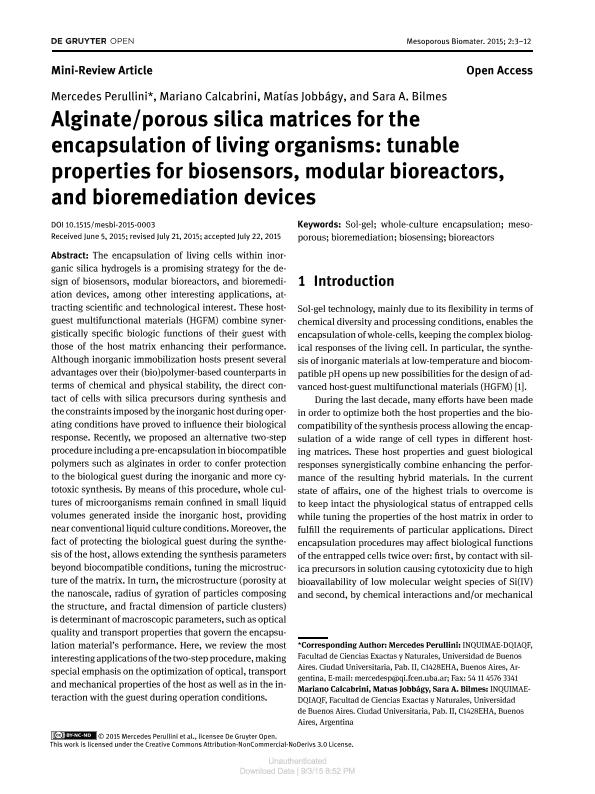Mostrar el registro sencillo del ítem
dc.contributor.author
Perullini, Ana Mercedes

dc.contributor.author
Calcabrini, Mariano
dc.contributor.author
Jobbagy, Matias

dc.contributor.author
Aldabe, Sara Alfonsina

dc.date.available
2018-09-10T16:48:36Z
dc.date.issued
2015-08
dc.identifier.citation
Perullini, Ana Mercedes; Calcabrini, Mariano; Jobbagy, Matias; Aldabe, Sara Alfonsina; Alginate/porous silica matrices for the encapsulation of living organisms: tunable properties for biosensors, modular bioreactors, and bioremediation devices; De Gruyter; Open Material Sciences; 2; 1; 8-2015; 3-12
dc.identifier.issn
2544-7300
dc.identifier.uri
http://hdl.handle.net/11336/58900
dc.description.abstract
The encapsulation of living cells within inorganic silica hydrogels is a promising strategy for the design of biosensors, modular bioreactors, and bioremediation devices, among other interesting applications, attracting scientific and technological interest. These host-guest multifunctional materials (HGFM) combine synergistically specific biologic functions of their guest with those of the host matrix enhancing their performance. Although inorganic immobilization hosts present several advantages over their (bio)polymer-based counterparts in terms of chemical and physical stability, the direct contact of cells with silica precursors during synthesis and the constraints imposed by the inorganic host during operating conditions have proved to influence their biological response. Recently we proposed an alternative two-step procedure including a pre-encapsulation in biocompatible polymers such as alginates in order to confer protection to the biological guest during the inorganic and more cytotoxic synthesis. By means of this procedure, whole cultures of microorganisms remain confined in small liquid volumes generated inside the inorganic host, providing near conventional liquid culture conditions. Moreover, the fact of protecting the biological guest during the synthesis of the host, allows extending the synthesis parameters beyond biocompatible conditions, tuning the microstructure of the matrix. In turn, the microstructure (porosity at the nanoscale, radius of gyration of particles composing the structure, and fractal dimension of particle clusters) is determinant of macroscopic parameters, such as optical quality and transport properties that govern the encapsulation material´s performance. Here we review the most interesting applications of the two-step procedure, making special emphasis on the optimization of optical, transport and mechanical properties of the host as well as in the interaction with the guest during operation conditions.
dc.format
application/pdf
dc.language.iso
eng
dc.publisher
De Gruyter
dc.rights
info:eu-repo/semantics/openAccess
dc.rights.uri
https://creativecommons.org/licenses/by-nc-sa/2.5/ar/
dc.subject
Sol-Gel
dc.subject
Whole-Culture Encapsulation
dc.subject
Mesoporous
dc.subject
Bioremediation
dc.subject
Biosensing
dc.subject
Bioreactors
dc.subject.classification
Otras Ciencias Químicas

dc.subject.classification
Ciencias Químicas

dc.subject.classification
CIENCIAS NATURALES Y EXACTAS

dc.title
Alginate/porous silica matrices for the encapsulation of living organisms: tunable properties for biosensors, modular bioreactors, and bioremediation devices
dc.type
info:eu-repo/semantics/article
dc.type
info:ar-repo/semantics/artículo
dc.type
info:eu-repo/semantics/publishedVersion
dc.date.updated
2018-09-04T19:04:23Z
dc.journal.volume
2
dc.journal.number
1
dc.journal.pagination
3-12
dc.journal.pais
Polonia

dc.journal.ciudad
Varsovia
dc.description.fil
Fil: Perullini, Ana Mercedes. Consejo Nacional de Investigaciones Científicas y Técnicas. Oficina de Coordinación Administrativa Ciudad Universitaria. Instituto de Química, Física de los Materiales, Medioambiente y Energía. Universidad de Buenos Aires. Facultad de Ciencias Exactas y Naturales. Instituto de Química, Física de los Materiales, Medioambiente y Energía; Argentina
dc.description.fil
Fil: Calcabrini, Mariano. Consejo Nacional de Investigaciones Científicas y Técnicas. Oficina de Coordinación Administrativa Ciudad Universitaria. Instituto de Química, Física de los Materiales, Medioambiente y Energía. Universidad de Buenos Aires. Facultad de Ciencias Exactas y Naturales. Instituto de Química, Física de los Materiales, Medioambiente y Energía; Argentina
dc.description.fil
Fil: Jobbagy, Matias. Consejo Nacional de Investigaciones Científicas y Técnicas. Oficina de Coordinación Administrativa Ciudad Universitaria. Instituto de Química, Física de los Materiales, Medioambiente y Energía. Universidad de Buenos Aires. Facultad de Ciencias Exactas y Naturales. Instituto de Química, Física de los Materiales, Medioambiente y Energía; Argentina
dc.description.fil
Fil: Aldabe, Sara Alfonsina. Consejo Nacional de Investigaciones Científicas y Técnicas. Oficina de Coordinación Administrativa Ciudad Universitaria. Instituto de Química, Física de los Materiales, Medioambiente y Energía. Universidad de Buenos Aires. Facultad de Ciencias Exactas y Naturales. Instituto de Química, Física de los Materiales, Medioambiente y Energía; Argentina
dc.journal.title
Open Material Sciences
dc.relation.alternativeid
info:eu-repo/semantics/altIdentifier/doi/https://dx.doi.org/10.1515/mesbi-2015-0003
dc.relation.alternativeid
info:eu-repo/semantics/altIdentifier/url/https://www.degruyter.com/view/j/oms.2015.2.issue-1/mesbi-2015-0003/mesbi-2015-0003.xml
Archivos asociados
